I am new to fitting gamm models and ran into two problems with my analysis.
I ran the same model using the gam and the bam function of the package mgcv. The models give me different estimates, and I don't understand why and how to choose which function to use. Can anyone explain to me why these functions give different estimates?
I am estimating a model including an interaction between age and condition (binomial factor with 2 conditions). For some reason one of the interaction terms (age:conditioncomputer or age:conditioncozmo) looks weird. It always gives a EDF and chi square of 0 and a p-value of 0.5, as if it was fixed to that. I tried using sum-to-zero and dummy contrasts, but that did not change the output. What is weird to me that there is a significant age effect, but this effect is not significant in neither condition. So I have the strong feeling that something is going wrong here.
Did anyone ever run into this before and can help me figure out if this is even a problem or normal, and how to solve it if it is a problem?
My model syntax is the following:
`bam(reciprocity ~ s(age,k=8) + condition + s(age, by = condition, k=8) + s(ID, bs="re") + s(class, bs="re") + s(school, bs="re"), data=df, family=binomial(link="logit"))`
This is the model output:
My df looks somewhat like this:
In short, I've used below code:
library(tidyverse)
library(psych)
library(mgcv)
library(ggplot2)
library(cowplot)
library(patchwork)
library(rstatix)
library(car)
library(yarrr)
library(itsadug)
df <- read.csv("/Users/lucaleisten/Desktop/Private/Master/Major_project/Data/test/test.csv", sep=",")
df$ID <- as.factor(as.character(df$ID))
df$condition <- as.factor(df$condition)
df$school <- as.factor(df$school)
df$class <- as.factor(df$class)
df$reciprocity <- as.factor(as.character(df$reciprocity))
summary(df)
model_reciprocity <- bam(reciprocity ~ s(age,k=7) +condition + s(age, by = condition, k=7) + s(ID, bs="re") + s(class, bs="re") + s(school, bs="re"), data=df, family=binomial(link="logit"))
summary(model_reciprocity)

